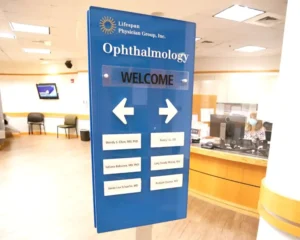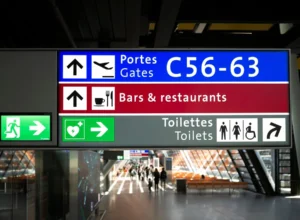Have you ever entered a large office building, a hospital, or a mall and instinctively found your way around the space without the aid of a person? That’s the unspoken power of directional signage; it’s a visual navigator that makes navigation easier, and it quietly supports a brand’s identity.
In the fast-paced world of settings such as industries, corporate buildings, educational campuses, hotels, or healthcare facilities, directional signs are not just helpful; they now appear to be essential devices for design, layout, and user experience. Let’s investigate how directional signage is shaping modern infrastructure and why it is an increasing aspect of any type of arrangement.
Imagine walking into a maze, and you have entered a place where directions are vital, so choose such signs that are always important and lead you to such a place where you need to be. Directional signage is more than just the sign, safeguarding visitors and staff and guiding them, and signage is everywhere which is visible.
What is Directional Signage?
Directional signage, otherwise referred to as wayfinding signage, assists individuals in travelling from one place to another in a timely or efficient manner. For example, it can be a directional sign with arrows indicating the location of restrooms, or a directory indicating the floor levels where girls are located, or a map showing the building’s lay of the land. Directional signage has a specific purpose: to assist with directing individuals without difficulty.
Direction signage is intentionally placed within lobbies, corridors, parking lots, elevators, and pathways to guide individuals to their destinations. However, today, directional signage is used for much more than just giving directions; it communicates professionalism, aesthetics, and collectiveness of the brand.
The Importance of Directional Signs and Their Role
Improves Visitor Experience
Nothing annoys a visitor more than having no idea where they are. A well-designed directional signage helps visitors to make them notice and guide them to their destination. Each little sign has its own importance and use, and directional signage ensures its role.
Reflects The Brand Presence
Custom directional signage can include an organization’s logo, text, color and typography, and now with the perks of customization that you can add. Directional signs can incorporate branding elements like a logo, colors, and typography. Designing your directional signage is also a good opportunity to have consistency in all of your signs and creates a consistent brand experience for the visitor before they set foot into the conference room.
Increases Safety and Accessibility
In an emergency, directional signage can be a lifesaver. It is important that areas such as exit routes, fire exits, and emergency assembly points are clearly identified for everyone’s safety. ADA-compliant signage with tactile lettering and Braille also help ensure accessibility for persons with disabilities.
Saves Marketing Time and Energy
Many times, employees and other visitors spend time asking for directions and wandering about before getting to their destination due to a lack of directional signage. Directional signage saves employee time and visitor time and energy when they know where to go or can see visible signage to help them along the way, because they don’t have to double back or go into areas that are clearly marked employee access only.
Enhances Aesthetic Value
Modern directional signage is designed to be visually appealing. Using premium materials like acrylic, stainless steel, aluminium, or glass, these signs blend with interiors, adding a sophisticated touch to corporate or public spaces.
Directional signage can come in a variety of types based on its location and purpose. Some common types of directional signage include:
Wall-mounted signs and Areas:
This signage is suited for hallways and internal wayfinding navigation.
Ceiling-hung sign:
This type of signage is simple and seen in places like airports, hospitals, and allows for long distance appropriate view.
Free-standing pylons and totems:
These types are excellent for outdoor or reception areas.
Floor directories:
This type of signage works well in multi-storey buildings and provides floor-dependent information.
Digital wayfinding display:
Digitally, with a wide screen, mostly we see the signs being shown, along with information.
Each one serves its intended purpose, but they complement each other to develop a unified wayfinding system. This makes navigation more intuitive.

Design Attributes That Contribute to Effective Directional Signage
Making a signage that functions well and looks attractive takes thoughtfulness with respect to a number of design principles:
Clarity and Simplicity:
Choose some things which are eye catchy and bold at the same time for better eye contact, and choosing with clarity is also a plus point.
Contrast and Visibility:
Visibility and contrast matters the most, just to grab people’s attention and help with the readability from distance.
Consistency:
Be consistent with all signs (fonts, color, material).
Placement:
Display the signage at eye-level or otherwise create signs at logical decision points where users expect to choose sign directions.
Lighting:
For outdoor or low-light situations, be sure the signs are illuminated or reflective.
These design cues will help keep the signs not only looking attractive but also functioning highly.
Directional signage in different industries
Corporate Office: encompassing your clients, partners or new employees will be effortlessly moved throughout the meeting rooms, departments and building facilities.
Hospitals: when time is critical for patients and visitors in large facilities, and quality is important.
Schools: Students or visitors will easily be able to move towards classroom space, auditorium space and administrative offices.
Malls and shopping spaces are all better experiences for all shoppers when improved directional signage allows you to navigate multiple floors and spaces between stores.
Hotels and Resorts: Will take guests to the amenities when the finishes display the brand’s look and feel, like any restaurant, spa or banquet room.
Regardless of industry, directional signage enhances both the user experience and flow of operation.
The New Age: Digital Directional Signage
As technology continues to evolve, many organizations are transitioning to the use of digital wayfinding. These touch-screen directories and smart maps allow users to search for a destination within a building or across a campus. Digital signage can even be utilized to communicate pertinent information in real time, such as meeting times or event status.
While traditional signage is important to include, adding digital elements creates interactivity and adaptive functionality in location awareness, which aligns with the changes of smart buildings.

Reasons to Choose a Printing Company for Directional Signage
From design development to fabrication and installation, a directional sign from services encompasses functional characteristics, design, and brand personality into a single delivered package. Each job is completed using high-quality materials and individual printing that ensures the durability and visual appearance. Regardless of your signage needs, indoor office wayfinding systems or outdoor directional pylons provide a professional sign while ensuring everything matches your corporate culture and architectural style.
Final Thoughts
Directional signs are beyond just a navigational tool; they are part of how people experience a designed space. In addition to improved accessibility, safe navigation, and saving time, directional signs inform clients, customers, and staff about a quality and professional business. Thus, directional signage is a key source that helps customers reach their destination, and when it comes to navigation, getting it from a reputable organization is also important. And what we see is that all types of areas covers with navigational and directional signs.



